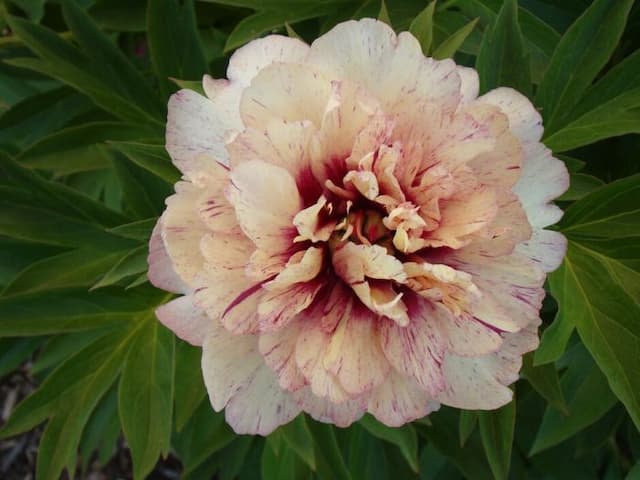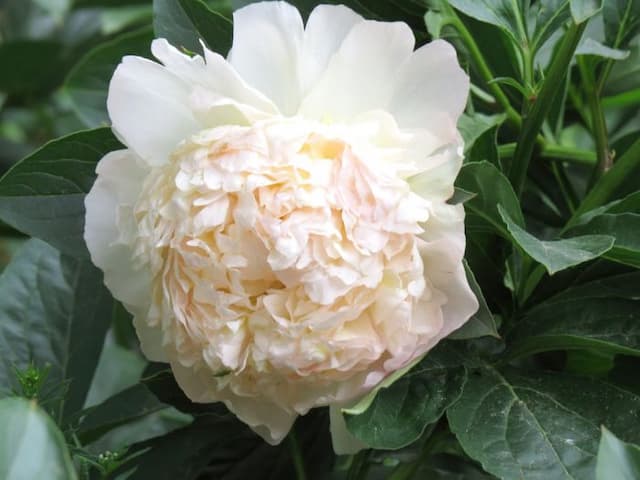Chinese Peony Paeonia lactiflora 'Emma Klehm'

ABOUT
Peony 'Emma Klehm' displays a lavish aesthetic with its full, rounded blooms of a soft pink hue that may deepen towards the center. The cupped and densely-packed petals often show a touch of silver at their tips, adding to the flower’s opulent charm. Each flower is a generous bouquet on its own, exuding a delicate fragrance that enhances its garden appeal. The leaves of 'Emma Klehm' complement the blooms with their deep green, glossy appearance, providing a lush backdrop for the spectacular flowers. The plant has a bushy, clumping form and the blooms are supported by sturdy stems that rise above the foliage, presenting the flowers prominently when in bloom. The overall impression of Peony 'Emma Klehm' is one of classic garden elegance, with a color palette that is both soothing and romantically reminiscent of old-fashioned gardens.
About this plant
 Names
NamesFamily
Paeoniaceae
Synonyms
Chinese Peony, White Peony, Garden Peony
Common names
Paeonia lactiflora 'Emma Klehm'.
 Toxicity
ToxicityTo humans
Peony (Paeonia lactiflora 'Emma Klehm') is generally not considered highly toxic to humans. If ingested in large quantities, it can cause mild stomach upset, nausea, or diarrhea. The plant contains compounds like paeonol, which can be irritating to the digestive system, but serious cases of poisoning are rare.
To pets
Peony (Paeonia lactiflora 'Emma Klehm') is considered to be mildly toxic to pets, including dogs and cats. If pets ingest part of a peony plant, they may experience symptoms such as vomiting, diarrhea, or drooling. Contact with the sap can also cause skin irritation. While the plant is not usually life-threatening, ingesting large quantities could be more harmful, and any suspected poisoning should be evaluated by a veterinarian.
 Characteristics
CharacteristicsLife cycle
Perennials
Foliage type
Deciduous
Color of leaves
Green
Flower color
Pink
Height
2-3 feet (60-90 cm)
Spread
2-3 feet (60-90 cm)
Plant type
Herb
Hardiness zones
3-8
Native area
Asia
Benefits
 General Benefits
General Benefits- Ornamental Value: Peony 'Emma Klehm' is highly sought after for its large, attractive blooms that add a dramatic flair to any garden or landscape.
- Aesthetic Appeal: With its lush, deeply green foliage and strikingly colorful flowers, this peony cultivar can enhance the visual appeal of an outdoor space.
- Fragrance: The flowers emit a pleasant fragrance that can perfume the air in the surrounding area, creating a delightful sensory experience.
- Longevity: Peonies have a long lifespan, which means they can provide beauty and enjoyment for many years with proper care.
- Hardiness: 'Emma Klehm' is known for being a robust plant that can withstand cold winters and is hardy in a range of climate zones.
- Pollinator Friendly: These flowers are attractive to bees and other pollinators, thereby supporting local biodiversity and contributing to the health of ecosystems.
- Cut Flowers: The blooms make excellent cut flowers for arrangements, ensuring their ornamental value extends indoors as well.
- Low Maintenance: Once established, peonies like 'Emma Klehm' require minimal maintenance, making them ideal for gardeners looking for plants that don't need constant attention.
 Medical Properties
Medical Properties- Anti-inflammatory: The root of Paeonia lactiflora, commonly known as white peony, has been used traditionally in Chinese medicine to reduce inflammation.
- Analgesic: Compounds within white peony may have pain-relieving properties.
- Immunomodulatory: Some studies suggest that extracts of white peony root can modulate immune system activity.
- Antioxidant: The plant contains antioxidants, which can help in preventing cellular damage from free radicals.
- Antispasmodic: Traditional use includes alleviating muscle spasms and cramps.
- Neuroprotective: There is some evidence to suggest that white peony might have protective effects on the nervous system.
- Gastroprotective: It may offer protective benefits for the gastrointestinal system.
 Air-purifying Qualities
Air-purifying QualitiesThis plant is not specifically known for air purifying qualities.
 Other Uses
Other Uses- The petals of the Peony 'Emma Klehm' can be used to make a natural dye for fabrics, imparting a delicate pink to purple hue.
- As a symbol of prosperity and good fortune, Peony flowers are often used in bridal bouquets and wedding decorations.
- Peony blooms can be floated in large bowls as a sophisticated and aromatic centerpiece for summer events.
- Dried Peony petals are incorporated in potpourri mixes, adding fragrance and a touch of elegance to a room.
- The lush foliage of the Peony can add greenery to floral arrangements even after the blooming season has ended.
- Petals of this Peony variety are sometimes used in crafting, for creating flower-imprinted papers or botanical jewelry.
- Peony 'Emma Klehm' can be used in photography as a subject for their exquisite beauty, especially for macro photography.
- The large, striking blooms are popular in still life paintings, showcasing the complexity and beauty of the flower.
- Peony plants are used in landscaping to create borders or as focal points in garden designs due to their impressive blooms.
- The plant's root system can help prevent soil erosion in gardens, making it not only beautiful but also functional in garden planning.
Interesting Facts
 Feng Shui
Feng ShuiThe Peony is not used in Feng Shui practice.
 Zodiac Sign Compitability
Zodiac Sign CompitabilityThe Peony is not used in astrology practice.
 Plant Symbolism
Plant Symbolism- Romance and Love: Peonies, including the 'Emma Klehm' variety, are often associated with love and romantic relationships due to their lush, full blooms that symbolize the beauty and joy of love.
- Prosperity: In many cultures, peonies are considered a sign of good luck and prosperity, with the belief that they bring fortune and positive outcomes to those who nurture them.
- Honor and Nobility: Historically, peonies have been associated with nobility and honor, particularly in Eastern traditions, representing the regal dignity and respect accorded to those of high status.
- Happiness and Compassion: The fullness and vibrant colors of the peony, including 'Emma Klehm', are seen as a symbol of happiness and compassion, as they uplift the spirits and encourage a sense of well-being and empathy in interpersonal relationships.
- Wealth: As a symbol of prosperity, peonies are also linked with wealth, with the belief that they can attract financial success and abundance into an individual's life.
 Water
WaterThe common Peony 'Emma Klehm' should be watered deeply once a week, ensuring that the soil is moist but not waterlogged. It's best to avoid overhead watering to prevent fungal diseases, so water at the base of the plant. During the growing season, an approximate guideline is to provide one inch of water weekly. Adjustments must be made depending on weather conditions; more frequent watering may be necessary during prolonged dry spells or extreme heat. Always check the top few inches of soil for dryness before watering; if it's still moist, delay watering until it dries out a bit.
 Light
LightPeonies like 'Emma Klehm' thrive in full sun to partial shade. They should receive at least six hours of sunlight daily; however, in regions with very hot summers, some afternoon shade can be beneficial to prevent overheating. The ideal spot for this peony would be somewhere it can enjoy the morning sun, which is less intense, and receive some protection from the harsh afternoon light.
 Temperature
TemperaturePeonies such as 'Emma Klehm' prefer temperate climates and are hardy in USDA zones 3 through 8, which means they can withstand winter temperatures down to -40 degrees Fahrenheit and are comfortable up to around 85 degrees Fahrenheit. The ideal growing temperature for these plants is between 65 and 75 degrees Fahrenheit during their blooming season in spring to early summer.
 Pruning
PruningPruning Peony 'Emma Klehm' mainly involves cutting back the foliage in the fall after the leaves have died back, to minimize the risk of disease. Additionally, remove spent flowers after blooming to encourage more blooms. The best time for significant pruning is late fall or early winter; however, any dead or damaged stems can be removed as needed throughout the year.
 Cleaning
CleaningAs needed
 Soil
SoilPeony 'Emma Klehm' thrives in well-draining, fertile soil with a neutral to slightly acidic pH of 6.5 to 7.0. A good soil mix includes equal parts garden soil, compost, and perlite or coarse sand to facilitate drainage. Regular amendments with organic matter help maintain soil fertility.
 Repotting
RepottingPeonies including 'Emma Klehm' are generally not repotted often; they prefer to be left undisturbed and can thrive in the same location for many years. Repotting is only necessary if the plant outgrows its space or if soil health needs to be revived, typically every 10-15 years.
 Humidity & Misting
Humidity & MistingPeony 'Emma Klehm' is tolerant of a wide range of humidity levels and does not require any special humidity conditions. Average outdoor humidity is typically adequate for this peony, as they are quite adaptable to different environments.
 Suitable locations
Suitable locationsIndoor
Growing peonies like 'Emma Klehm' indoors is challenging; they need cold to bloom.
Outdoor
Plant in sun, well-drained soil; water deeply but infrequently.
Hardiness zone
3-8 USDA
 Life cycle
Life cycleThe Chinese Peony 'Emma Klehm' begins its life cycle as a seed, which, when planted in well-drained soil and with adequate sunlight, will germinate to produce a small seedling. The seedling develops into a young plant with distinctive lobed leaves and grows until it reaches maturity, at which point it forms a robust root system and a woody base. During the spring, mature plants produce large, fragrant blossoms that are often pink, white, or red, and attract pollinators such as bees. After flowering, the plant sets seed contained within a follicle that, if not deadheaded, will mature and eventually disperse to propagate new plants. With the onset of autumn, the plant's above-ground foliage dies back, and the plant enters a period of dormancy over the winter, relying on the energy reserves in its roots. The growth cycle resumes in the spring when new shoots emerge from the roots, leading to the annual regeneration of its stems and leaves.
 Propogation
PropogationPropogation time
Early Spring
Paeonia lactiflora 'Emma Klehm', commonly known as the peony 'Emma Klehm', is best propagated through division, which is most successfully done in the fall after the plants have gone dormant. To propagate by division, carefully dig up the entire plant, taking care not to damage the roots more than necessary. The root clumps should be cut into sections, with each section containing at least three to five eyes, which are the dormant buds. Replant the divisions at the same depth they were previously growing, ensuring the eyes are 1-2 inches below the soil surface (approximately 2.5-5 centimeters). This allows for sufficient insulation during the winter and proper sprouting in the spring. Keep the newly planted divisions watered adequately to help establish them before the onset of winter.






![Peony [Red Sarah Bernhardt]](/_next/image?url=https%3A%2F%2Fplants-admin.emdemapps.com%2Fimages%2Fplants%2F%2Fimages%2F604b5369d170e.png&w=640&q=75)


